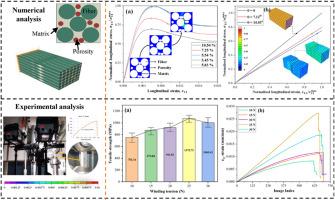缠绕张力对长丝缠绕CFRP复合材料孔隙率、错位及力学性能的多尺度研究
IF 9.8
1区 材料科学
Q1 MATERIALS SCIENCE, COMPOSITES
引用次数: 0
摘要
纤维缠绕复合材料结构的质量和性能受到缠绕参数的显著影响,尤其是缠绕张力。缠绕张力影响树脂流动、孔隙形成、纤维排列,最终影响复合材料制品的机械性能。本研究探讨了缠绕张力对碳纤维增强聚合物复合材料结构完整性的影响,并确定了性能变化的根本原因。采用了多尺度分析、数值和实验相结合的方法。分析模型描述了缠绕张力、树脂流动、空隙生长、残余应力和纤维床压实之间的关系。使用代表性体积单元的数值模拟捕获了张力对纤维错位的微观结构影响(即使纤维错位7.12°也会降低高达20%的抗拉强度)和孔隙率,以及它们对应力分布和整体机械行为的影响。实验研究包括准静态拉伸测试、x射线断层扫描、光学显微镜和断口学,以验证模型并检查损伤机制。结果表明,将缠绕张力提高至25 N,可改善纤维取向,降低孔隙率,从而提高复合材料的强度。然而,超过这一水平的张力会导致更高的残余应力和较低的机械性能,因为纤维损伤和不完全树脂渗透。该研究确定25 N为最佳附加缠绕张力,在改善结构性能的同时实现5.54%的孔隙率。这些发现有助于更好地理解工艺结构关系,并为优化复合材料压力容器等高性能丝缠绕复合材料结构的制造提供指导。本文章由计算机程序翻译,如有差异,请以英文原文为准。

Multiscale investigation of winding tension on porosity, misalignment, and mechanical performance of filament-wound CFRP composites
The quality and performance of filament-wound composite structures are significantly influenced by winding parameters, particularly the applied winding tension. Winding tension affects resin flow, porosity formation, fiber alignment, and ultimately the mechanical performance of the composite product. This study investigates the effects of winding tension on the structural integrity of carbon fiber-reinforced polymer composites and identifies the root causes of performance variations. A multiscale approach combining analytical, numerical, and experimental methods is employed. Analytical models describe the relationships between winding tension, resin flow, void growth, residual stress, and fiber bed compaction. Numerical simulations using representative volume element capture the microstructural effects of tension on fiber misalignment (with even a 7.12° fiber misalignment can reduce tensile strength by up to 20 %) and porosity, as well as their influence on stress distribution and overall mechanical behavior. Experimental investigations, including quasi-static tensile testing, X-ray tomography, optical microscopy, and fractography, are conducted to validate the models and examine damage mechanisms. The results reveal that increasing winding tension up to 25 N improves fiber alignment and reduces porosity, thereby enhancing the strength of composite. However, tensions beyond this level lead to higher residual stresses and lower mechanical performance due to fiber damage and incomplete resin infiltration. The study identifies 25 N as the optimal additional winding tension, achieving a porosity of 5.54 % with improved structural performance. These findings contribute to better understanding of process–structure relationships and provide guidance for optimizing the manufacturing of high-performance filament-wound composite structures, such as composite pressure vessels.
求助全文
通过发布文献求助,成功后即可免费获取论文全文。
去求助
来源期刊

Composites Science and Technology
工程技术-材料科学:复合
CiteScore
16.20
自引率
9.90%
发文量
611
审稿时长
33 days
期刊介绍:
Composites Science and Technology publishes refereed original articles on the fundamental and applied science of engineering composites. The focus of this journal is on polymeric matrix composites with reinforcements/fillers ranging from nano- to macro-scale. CSTE encourages manuscripts reporting unique, innovative contributions to the physics, chemistry, materials science and applied mechanics aspects of advanced composites.
Besides traditional fiber reinforced composites, novel composites with significant potential for engineering applications are encouraged.
 求助内容:
求助内容: 应助结果提醒方式:
应助结果提醒方式:


